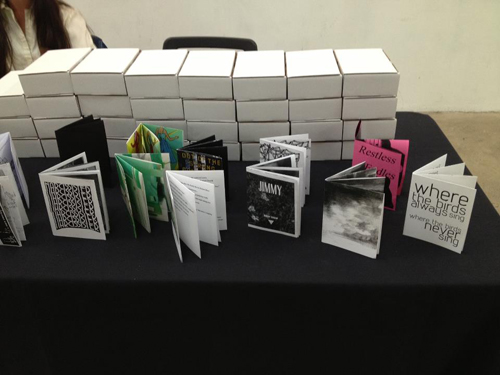
Release party for Darin Klein and Friends’ Box of Books Vol. V, Human Resources, Los Angeles, October 2012. Courtesy The Art Book Review.
Darin Klein and Friends’ Box of Books project is a simple idea that produces extraordinary results. Twenty or so artists are each asked to make a unique zine. The zine must utilize a specific format in which an 11 x 17-inch sheet of paper is folded and cut so as to make a compact eight-page booklet. All the zines are then collected in a box and an edition of 100 boxes is produced, with each zine numbered and signed by the artist.
Klein has organized five of these boxed collections to date, working with over 100 artists from diverse backgrounds, most of them based in San Francisco (where Klein lived for many years) and Los Angeles (where he is now based). In 2012, a special edition was produced in collaboration with the participants of a daylong workshop at the Hammer Museum, where Klein works as Public Programs Associate. On January 31, Box of Books Vol. VI (with an expanded edition of 150) will be released at Printed Matter’s first ever Los Angeles Art Book Fair for which Klein served as a key advisor.
Klein is known around town as a true zine fanatic—an avid collector, promoter, creator, and publisher of indie publications with deep roots in the West Coast underground scene. In 2007, he was invited by artist and publisher AA Bronson to be an exhibitor in the New York Art Book Fair, where he showcased a few of his own titles along with a variety of works by friends in L.A. His booth was a big hit, but he noticed that it was hard for customers to choose which items to buy; he decided that an affordable boxed set of works by multiple artists would be the ideal solution. Through this deceptively utilitarian principle, Box of Books was born.
Marina Eckler. “Part of You Could Come Apart” from Box of Books Vol. I
Box of Books clearly emerged out of DIY zine culture; it is cheaply and simply produced, with a guerrilla can-do attitude, and each box sells for a mere $20. However, it is also striking how much the boxes recall and elegantly fit into the lineage of twentieth-century artists’ books. Books in box form appeared in the Fluxus movement; and as the catalogue for the major John Cage exhibition, Rolywholyover A Circus (1993). In both of those cases, the ability to touch and shuffle the box’s contents were key to their reception as subversive, non-linear objects. Box of Books’ serial issue and structural limitations also conjure minimalist and conceptual art practices dating back to the 1960s.
As the enthusiastic owner of four of these boxes—all of the official volumes, except for the elusive and sold-out Vol. II—I delight in the endless adventures to be had when dipping randomly into their contents. There is no end to the variety of ways that artists find to utilize this highly specific medium. Some stick with the narrative book format, such as Ray Cha’s clever Stories of the Future/Stories of the Past from Vol. V, which uses a recto-verso trick to create two books in one. Others are purely abstract to the point of becoming fold-out sculptures, such as Johanna Jackson’s polka-dot-stickers-on-vellum piece from Vol. IV.
Kirk Maxson. A page from “Holy Spirit,” included in Box of Books Vol. III
Some works come out of the graphic comic or queer zine traditions, such as Heather Benjamin’s dense, intensely sexual drawings from Vol. IV or Jimmy the Zine’s Daisy Chain account of past lovers from Vol. V. Some artists use both the front and back of the sheet to make books that also fold out into posters, the most elaborate of these being Tommy Kovac’s stunning The Weirdling Woods from Vol. V, pictured below. Other artists incorporate additional elements, such as the envelope labeled Summer 2011 that contains Francesca Mirabella’s complex vellum print from Vol. IV, or Kirk Maxson’s breathtaking Holy Spirit (pictured above) from Vol. III, into which he pinned paper moths and butterflies that he had cut out of three iconic books.
Tommy Kovac. “The Weirdling Woods,” included in Box of Books Vol. III
Sifting through the many works contained in these boxes, one is treated to a truly wide-ranging reading/viewing experience that encompasses the spectrum from grubby, Xeroxed black-and-white street zines to more conceptual or literary efforts to the most intricately crafted book-like works. In short, Box of Books is an incidental and sublime marriage between mass-produced punk zines and art school/print house limited editions/fetish objects.